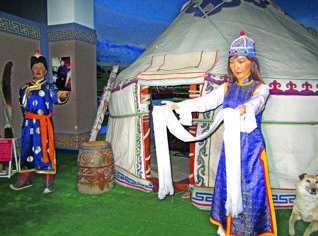Ancient Uyghur history shines in Chinese museum
ISTANBUL - Hürriyet Daily News

Opened in Urumqi’s People’s Park in 1953, the museum’s original main attraction was various Silk Road-related artifacts such as ancient written documents in several different languages and silk from various areas and eras. AA photos
The history of China’s Xinjiang Uyghur Autonomous Region and that of Uyghur Turks, which can be traced to before the 5th century BC, are explored in a museum boasting some 40,000 artifacts in the region’s capital, according to the Anatolia news agency.The Xinjiang Uygur Autonomous Region is an administrative division in the northwest of China. While it’s capital, Urumqi, is located in the center of the division, an estimated 80 percent of Xinjiang’s Uyghurs live in the southwestern part of the region, called the Tarim Basin. As one of the oldest Turkic ethnic groups, the museum aims to keep their history alive.
Opened in Urumqi’s People’s Park in 1953, the museum’s original main attraction was various Silk Road-related artifacts such as ancient written documents in several different languages and silk from various areas and eras, according to the Chinahighlights website. Some of the most significant archaeological discoveries of the area, unusually well-preserved mummies of the Caucasians who lived in the region between 1,500 and 4,000 years ago, were later discovered and housed there.
The history of China’s Xinjiang Uyghur Autonomous Region and that of Uyghur Turks, which can be traced to before the 5th century BC, are explored in a museum boasting some 40,000 artifacts in Urumqi, according to the Anatolia news agency.
Opened in Urumqi’s People’s Park in 1953, the museum’s original main attraction was various Silk Road-related artifacts such as ancient written documents in several different languages and silk from various areas and eras, according to the Chinahighlights website. Some of the most significant archaeological discoveries of the area, unusually well-preserved mummies of the Caucasians who lived in the region between 1,500 and 4,000 years ago, were later discovered and housed there.
Spanning 17,226 square meters, the museum also provides information on the customs of Uyghurs and ethnic groups in the region. Until two decades ago, Uyghur culture was hardly known to historians and archeologists, and their history and origins are still mysterious.
Caucasian mummies
Little is known about the many Caucasian graves and bodies that have been found around the region, and it is not clear whether they were all descended from the same groups or tribes, according to Chinahighlights.
The bodies and artifacts of Caucasians date from the Bronze Age 4,000 years ago to the Silk Road era 1,500 years ago. Perhaps some of the later mummies were simply travelers or traders in the area. It is clear that there were settlements of Caucasians about 3,000 and 4,000 years ago that predate any evidence of Mongoloid people by about 1,000 years. This suggests that the original settlers in the region were Caucasians.
The Caucasian people who lived during the Silk Road era from about 1 AD to 1,000 AD wrote in an Indo-European language called Tocharian. Some texts and inscriptions have been found as well as paintings of Caucasian people.
It is believed that Caucasian people supplied jade to the Shang Dynasty, as the jade found in a Shang Dynasty tomb is known to be from an area of Xinjiang near Tibet, according to Chinahighlights. It is known that Chinese highly valued jade and it was considered even more valuable than gold or other gemstones, however, Europeans and other cultures west of China did not regard the mineral so highly.
 History of the Uyghurs
History of the UyghursUyghur history can be divided into four distinct phases: Pre-Imperial (300 BC - 630 AD), Imperial (630 - 840 AD), Idiqut (840 - 1200 AD) and Mongol (1209 - 1600 AD), with perhaps a fifth modern phase running from the death of the Silk Road in 1600 AD until the present.
After the collapse of the Uyghur Khaganate empire in 840 AD, Uyghurs resettled from Mongolia to the Tarim Basin, assimilating the Indo-European population, which had previously been driven out of the region by the Xiongnu nomads.The ancestors of the Uyghur tribe were Turkic pastoralists called Tiele who lived in the valleys south of Lake Baikal and around the Yenisei River in what is today southern Russia.
The Uyghur identity
The Uyghur identity remains fragmented, as some support a Pan-Islamic vision (the East Turkestan Islamic Movement), while others support a Pan-Turkic vision (the East Turkestan Liberation Organization) and a third group wants a “Uyghurstan” state (the East Turkestan independence movement). As a result, no Uyghur or East Turkestan group speaks for all Uyghurs, although it may claim to, and Uyghurs in each of these camps have committed violence against other Uyghurs who they think are too assimilated to Chinese or Russian society or not religious enough.
















